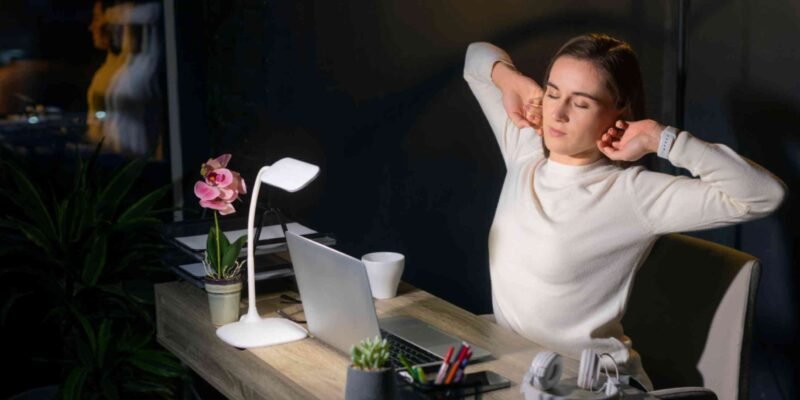
Sleep is a vital part of our lives, yet so many of us struggle to get the quality rest we need. But what if we told you that by optimizing your sleep environment, you could unlock the secret to better sleep? This article will dive into the various factors that contribute to a sleep-friendly environment and provide actionable tips to help you create the perfect sleep oasis.
Key Takeaways
- Light exposure, particularly blue light, can significantly impact your circadian rhythms and sleep quality.
- Temperature, noise, and humidity levels play a crucial role in creating a comfortable sleep environment.
- Simple adjustments to your bedroom setup can lead to improved sleep quality and overall well-being.
- Establishing a consistent sleep schedule and creating a relaxing pre-bedtime routine can enhance your sleep experience.
Brief Overview In our fast-paced, constantly connected world, getting a good night’s sleep has become a luxury for many. However, sleep is not only a necessity but also a key component of overall health and well-being. Neglecting proper sleep can lead to a host of issues, including decreased productivity, impaired cognitive function, and even long-term health consequences. The good news? By optimizing your sleep environment, you can significantly improve the quality of your sleep and wake up feeling refreshed and energized. Let’s explore the various factors that contribute to a sleep-friendly environment and how you can create your personal sleep oasis.
Lighting and Circadian Rhythms
The Impact of Light on Sleep
How Light Affects Circadian Rhythms Our bodies have an internal clock, known as the circadian rhythm, that regulates our sleep-wake cycle. This cycle is heavily influenced by exposure to light. When it’s dark, our bodies naturally produce more melatonin, the sleep-inducing hormone, which signals to our brain that it’s time to wind down and prepare for sleep.
For example, have you ever noticed how you feel more alert and energized on a bright, sunny day? That’s because the exposure to natural light suppresses melatonin production, keeping you awake and alert.
The Role of Artificial Light in Sleep While natural light is essential for regulating our circadian rhythms, artificial light can also have a significant impact on our sleep. The blue-ish light emitted by electronic devices, such as smartphones, tablets, and computers, can trick our brains into thinking it’s daytime, suppressing melatonin production and making it harder to fall asleep.
Have you ever found yourself scrolling through social media or binge-watching a show late at night, only to struggle to fall asleep afterwards? That’s the artificial light at work, disrupting your natural sleep-wake cycle.
Tips for Creating a Sleep-Friendly Lighting Environment
-
- Expose yourself to natural light during the day to help regulate your circadian rhythms.
- Dim the lights in your home a few hours before bedtime to signal to your body that it’s time to wind down.
- Avoid using electronic devices with blue light emissions at least an hour before bedtime.
- Use blackout curtains or an eye mask to block out any external light sources that could disrupt your sleep.
- Blue Light Exposure and Sleep
The Effects of Blue Light on Sleep As mentioned earlier, blue light exposure, particularly from electronic devices, can have a detrimental effect on sleep quality. This type of light suppresses melatonin production and tricks your brain into thinking it’s daytime, making it harder to fall asleep and stay asleep.
For instance, have you ever found yourself struggling to fall asleep after a late-night Netflix binge or a few hours of scrolling through social media on your phone? That’s the blue light at work, disrupting your body’s natural sleep-wake cycle.
Tips for Reducing Blue Light Exposure
- Enable the “night mode” or “blue light filter” on your electronic devices to reduce the amount of blue light emitted.
- Avoid using electronic devices at least an hour before bedtime, or consider wearing blue light-blocking glasses if you must use them.
- Limit exposure to bright outdoor lights in the evening hours, as they can also emit blue light.
- Consider installing warm-toned LED bulbs in your bedroom and other living areas to reduce blue light exposure.
Temperature and Sleep
The Ideal Temperature for Sleep
Why Temperature Matters for Sleep Have you ever tried to sleep in a room that’s too hot or too cold? It’s uncomfortable, right? That’s because temperature plays a crucial role in our ability to fall asleep and stay asleep. Our bodies naturally cool down as we prepare for sleep, and maintaining the right temperature can help facilitate this process.
For example, have you ever noticed how you tend to sleep better on cooler nights? That’s because a cooler temperature signals to your body that it’s time to rest and conserve energy.
The Ideal Temperature Range for Sleep According to sleep experts, the ideal temperature range for sleep is between 65°F (18.3°C) and 70°F (21.1°C). This temperature range is cool enough to facilitate the natural drop in body temperature that occurs during sleep, but not so cool that it becomes uncomfortable or causes shivering.
| Temperature Range | Ideal for Sleep |
|---|---|
| 65°F – 70°F | Yes |
| Below 65°F | Too Cold |
| Above 70°F | Too Warm |
Tips for Maintaining the Ideal Temperature for Sleep
- Use a programmable thermostat to adjust the temperature in your bedroom to the ideal range before bedtime.
- Invest in a fan or air conditioning unit to help cool down your bedroom on warmer nights.
- Use breathable, moisture-wicking bedding and sleepwear to avoid overheating during the night.
- Open windows or use a humidifier to maintain a comfortable humidity level, as dry air can exacerbate the perception of heat or cold.
Noise and Sleep
The Impact of Noise on Sleep
How Noise Affects Sleep Noise pollution can be a major sleep disruptor, making it difficult to fall asleep and stay asleep throughout the night. Even seemingly minor noises, like a ticking clock or the hum of a fan, can interfere with the quality of your sleep if you’re sensitive to them.
For instance, have you ever been jolted awake by a loud noise, like a car honking outside or a neighbor’s barking dog? Those sudden noises can disrupt your sleep cycle and make it challenging to fall back into a deep, restful sleep.
Tips for Creating a Quiet Sleep Environment
- Use earplugs or a white noise machine to mask external noises that could disrupt your sleep.
- Soundproof your bedroom by adding insulation, installing double-glazed windows, or using heavy curtains or rugs to absorb sound.
- Relocate your bedroom to a quieter area of your home, if possible, away from high-traffic areas or external noise sources.
- Ensure that any appliances or electronics in your bedroom are running quietly or consider removing them altogether.
Humidity and Sleep
The Impact of Humidity on Sleep
How Humidity Affects Sleep While temperature is often the primary focus when it comes to creating a sleep-friendly environment, humidity levels can also play a significant role in sleep quality. Both excessively high and low humidity levels can contribute to discomfort and sleep disruptions.
For example, have you ever woken up with a dry, scratchy throat or a stuffy nose due to low humidity levels? Or have you felt sweaty and sticky during the night because of high humidity? These conditions can make it challenging to fall asleep and stay asleep throughout the night.
Tips for Maintaining a Healthy Humidity Level for Sleep
- Use a humidifier in your bedroom during the drier months to maintain a comfortable humidity level between 30-50%.
- Invest in a dehumidifier if you live in a humid climate to reduce excess moisture in the air.
- Ensure proper ventilation in your bedroom to prevent moisture buildup and maintain healthy air circulation.
- Consider using moisture-wicking bedding and sleepwear to help regulate your body’s temperature and prevent excessive sweating or moisture buildup.
Additional Tips and Strategies
Creating a Sleep-Friendly Bedroom Environment
Tips for Creating a Sleep-Friendly Bedroom Environment In addition to addressing factors like light, temperature, noise, and humidity, there are several other elements that can contribute to a sleep-friendly bedroom environment:
Use comfortable, supportive bedding and pillows to ensure proper spinal alignment and reduce discomfort during the night.
- Keep your bedroom clutter-free and organized, as a cluttered space can contribute to feelings of stress and anxiety, making it harder to relax and fall asleep.
- Consider using calming colors and textures in your bedroom decor, as they can create a soothing atmosphere that promotes relaxation.
- Eliminate strong odors or fragrances in your bedroom, as they can be disruptive or trigger allergies or sensitivities.
- Use blackout curtains or an eye mask to block out any external light sources that could interfere with your sleep.
Examples of Sleep-Friendly Bedroom Environments Creating a sleep-friendly bedroom environment can take many forms, tailored to your personal preferences and needs. For instance, some people find that using essential oil diffusers with calming scents like lavender or chamomile can help them relax and unwind before bedtime.
Others prefer to create a minimalist, zen-like space with calming neutral colors, soft lighting, and minimal clutter. The key is to experiment and find what works best for you to create a space that promotes relaxation and restful sleep.
Maintaining a Consistent Sleep Schedule
The Importance of a Consistent Sleep Schedule Establishing and maintaining a consistent sleep schedule is crucial for optimizing your sleep quality and overall well-being. Our bodies thrive on routine, and by going to bed and waking up at the same time each day, you can help regulate your internal clock and improve your sleep patterns.
For example, have you ever noticed how you tend to feel more rested and energized after a few nights of consistent sleep and wake times? That’s because your body has adjusted to the routine, making it easier to fall asleep and wake up naturally.
Tips for Maintaining a Consistent Sleep Schedule
- Set a consistent bedtime and wake-up time, even on weekends and holidays, to help regulate your body’s internal clock.
- Establish a relaxing bedtime routine, such as taking a warm bath, reading a book, or practicing light stretching, to signal to your body that it’s time to wind down.
- Avoid napping during the day, as it can interfere with your ability to fall asleep at your designated bedtime.
- Limit exposure to blue light from electronic devices and bright lights in the evening hours, as they can disrupt your body’s natural sleep-wake cycle.
- Create a sleep-friendly environment by optimizing factors like light, temperature, noise, and humidity levels, as discussed earlier.
Conclusion
In this fast-paced world, where stress and demands often take precedence, prioritizing sleep is crucial for our overall well-being. By creating a healthy sleep environment, you can unlock the power of quality rest, which translates into improved cognitive function, enhanced mood, and better overall health.
Remember, optimizing your sleep environment is not a one-time task but an ongoing process of making adjustments and finding what works best for you. Whether it’s minimizing light exposure, maintaining the ideal temperature, or creating a peaceful, clutter-free space, each step you take towards creating a sleep-friendly environment can have a profound impact on the quality of your sleep and, consequently, your overall quality of life.
As research continues to uncover the intricate connections between sleep and overall health, the importance of creating a healthy sleep environment will only become more evident. Stay informed about the latest developments in sleep science and be open to incorporating new strategies and technologies that can enhance your sleep experience.













